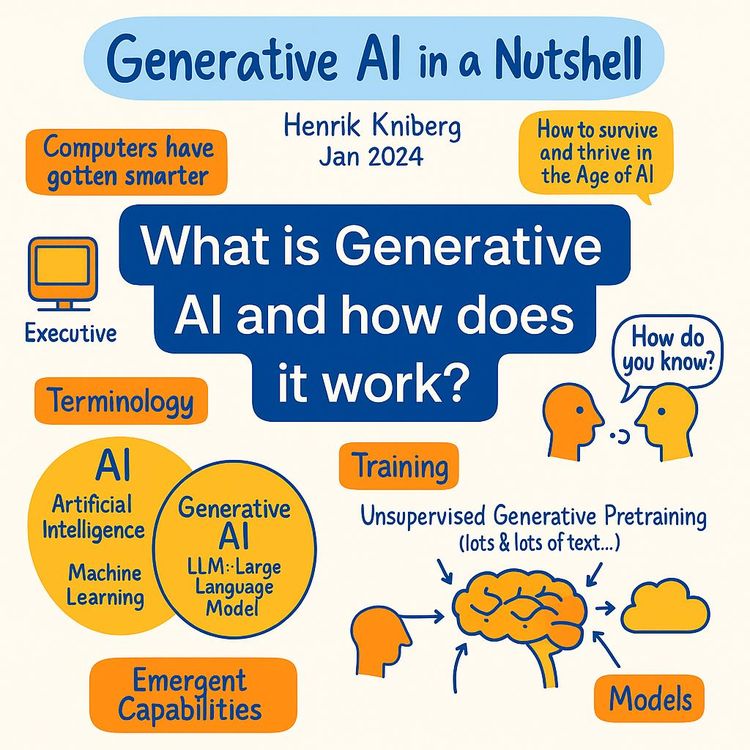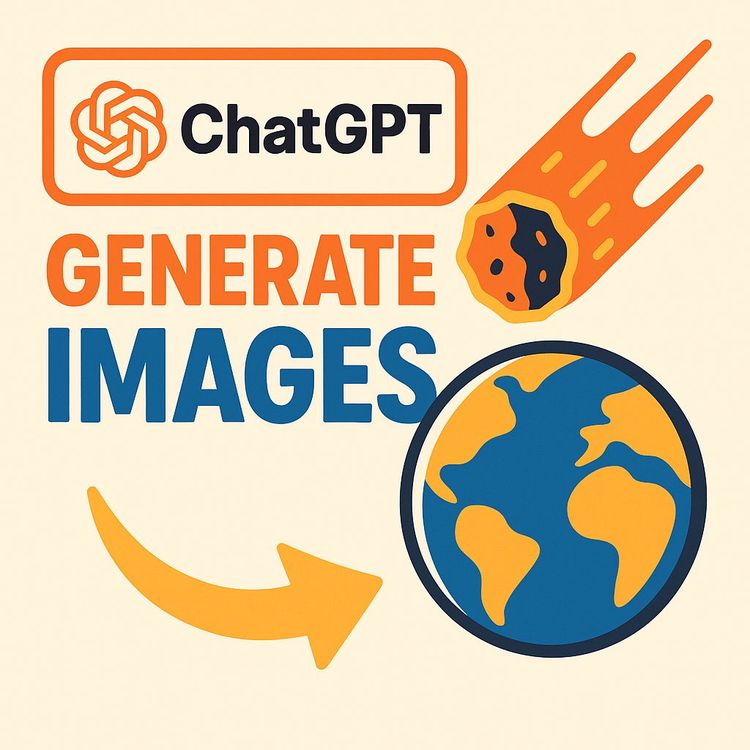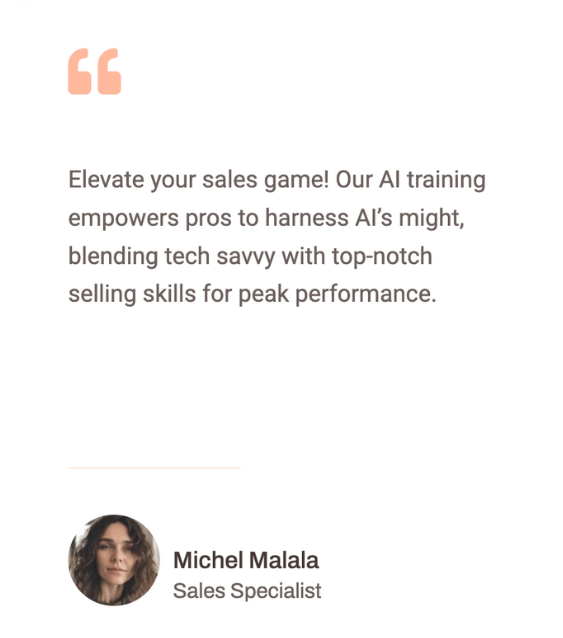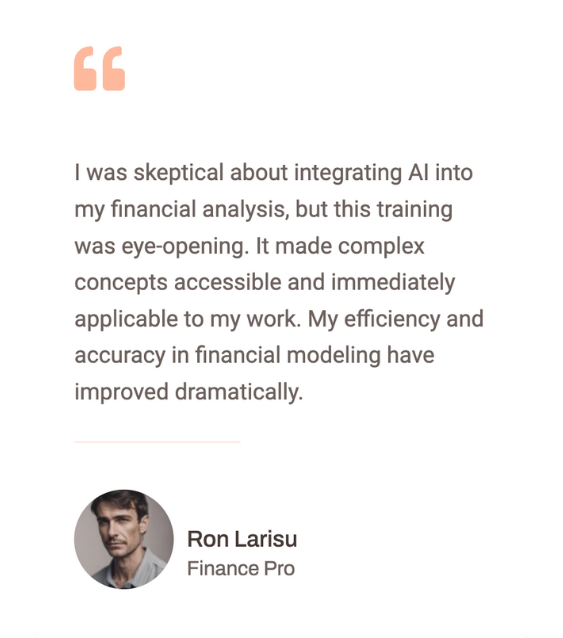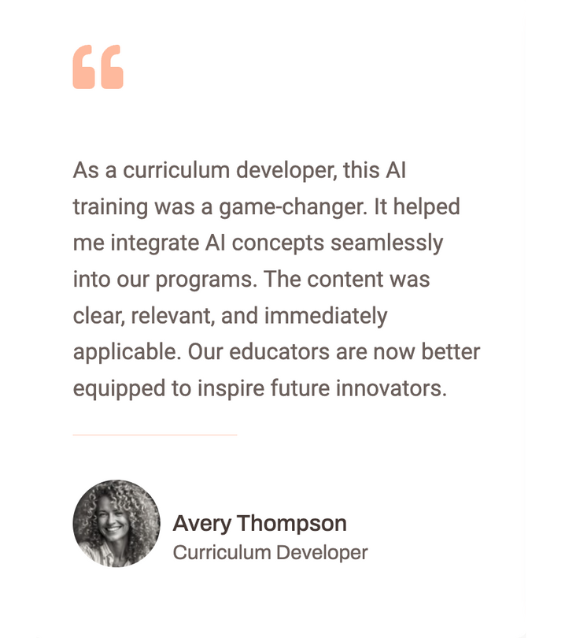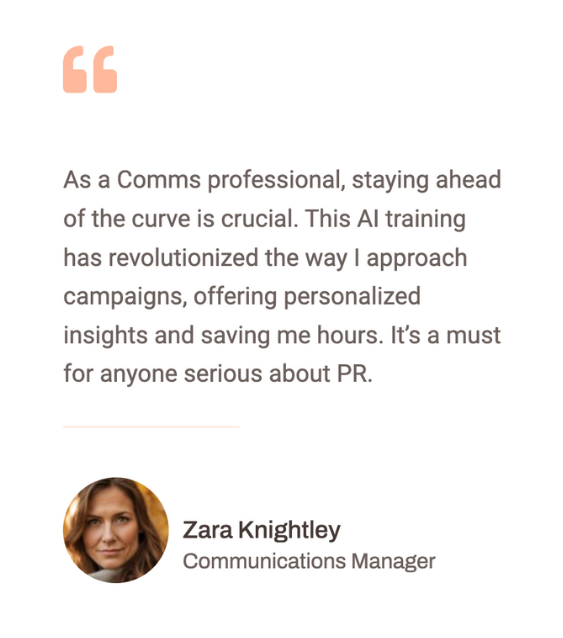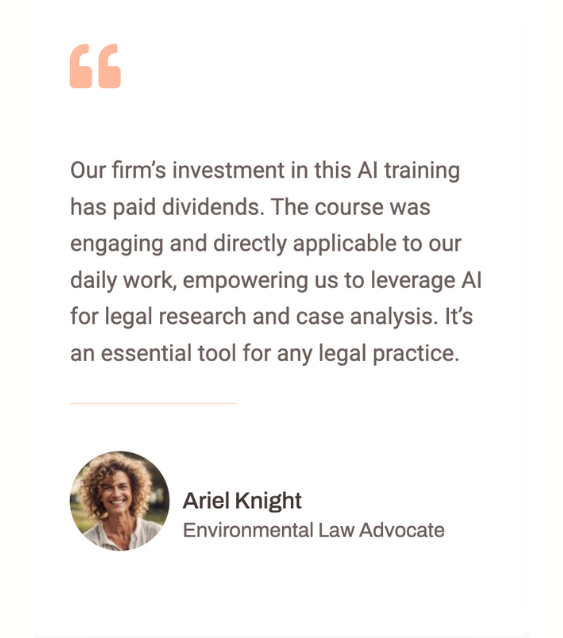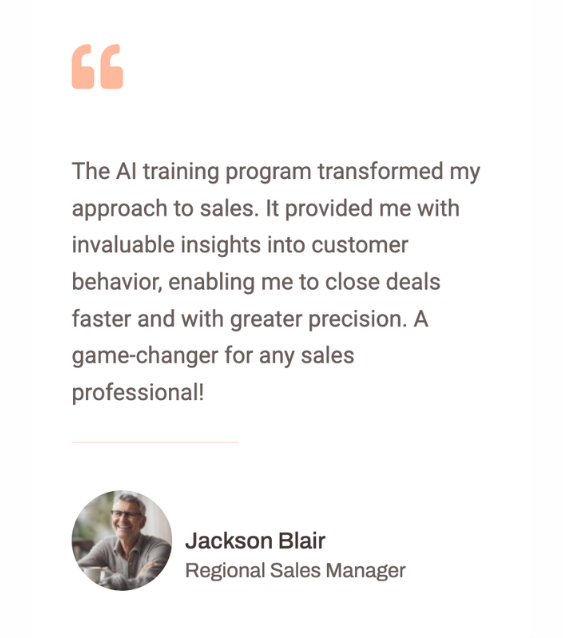AI Data Analysis With LLMs: Clean, Explore, Automate (Video Course)
Talk to your data and get real answers in minutes. This fast, hands-on course shows how to guide AI like a junior analyst, avoid guesswork with DIG, spot high-value wins with ACHIEVE, and turn one-off analyses into reusable tools.
Related Certification: Certification in LLM-Driven Data Cleaning, Exploration, and Automation
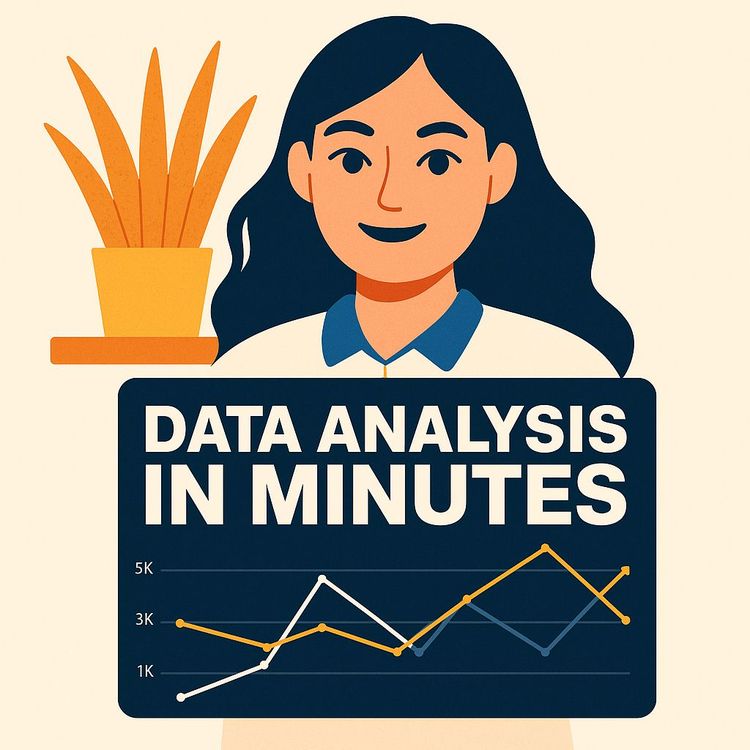
Also includes Access to All:
What You Will Learn
- Use the DIG framework to ground and guide AI analyses
- Identify high-value AI opportunities with the ACHIEVE framework
- Prevent and correct AI hallucinations with guardrails and traceability
- Apply intelligent filtering and multimedia analysis to diverse files
- Automate workflows into reproducible Python scripts and traceability docs
Study Guide
Data Analysis With AI In 21 Minutes
You don't need to be a data scientist to get insights from messy spreadsheets, transcripts, images, or a pile of files that no one wants to touch. With AI, your voice becomes the interface. You ask questions. It explores, cleans, visualizes, and even automates. This course is your fast-start, practical guide to doing real data analysis with AI,without wasting time on fluff. You'll learn the frameworks that keep AI accurate, the prompts that unlock useful results, and the workflows that turn a one-off analysis into a reusable tool you can run again and again.
We'll start with how to think about AI for analysis, then move into a structured process (DIG) that eliminates hallucinations and guesswork. You'll learn where AI creates the most value using the ACHIEVE framework. After that, we'll get into advanced moves: intelligent filtering, multimedia analysis, automating file organization, and turning your conversation into executable code. We'll wrap with use cases across education, business, and product work, plus a set of exercises to apply what you've learned immediately.
By the end, you'll have a system. A reliable way to turn raw data into decisions,and your analysis into leverage.
What You'll Learn
You will be able to: identify high-value AI use cases with the ACHIEVE framework; run accurate, goal-driven analysis with the DIG framework (Description, Introspection, Goal Setting); avoid and correct AI hallucinations; apply intelligent filtering beyond simple matching; analyze and transform multimedia; automate workflows into reusable Python scripts; create traceability documents for reproducibility; and convert analysis into reports, dashboards, or applications.
Key Concepts & Terminology
AI Data Analysis: Using AI models to clean, explore, interpret, visualize, and automate tasks with data,often through natural language prompts and file uploads.
ACHIEVE Framework: A guide for where AI delivers real value,Aiding human coordination, Cutting tedious tasks, Helping provide a safety net, Inspiring better problem-solving, Enabling ideas to scale faster.
DIG Framework: A three-step workflow,Description, Introspection, Goal Setting. It adapts classic Exploratory Data Analysis to a conversational AI environment.
Exploratory Data Analysis (EDA): The practice of understanding a dataset's structure, patterns, and issues before running formal models or drawing conclusions.
AI Hallucination: When an AI generates confident but incorrect information not supported by the input. Often caused by missing or misinterpreted data and vague instructions.
Traceability Document: A record of data sources, steps taken, methods used, and known limitations so anyone can replicate your analysis and understand its constraints.
Intelligent Filtering: AI's ability to filter by meaning or concept (e.g., "East Coast roles," "positive sentiment," "jobs involving woodwork") even when those labels aren't explicit in columns.
Mindset: Treat AI Like a Junior Analyst
The best results come when you treat AI as a competent junior analyst: give clear direction, verify understanding early, and hold it accountable to your goals. You are the thinker; it is the assistant. If you skip the basics, you'll get clever nonsense. If you stick to the process, you'll get reliable insights and speed.
Example 1:
Ask the AI to list the columns and show five sample rows before any analysis. This catches issues like dates parsed as text or currencies mixed across rows.
Example 2:
After the AI proposes questions, challenge it: "Which of these are unsupported by the actual columns? Cross-check and remove them." You force rigor up front and avoid wasted time later.
When to Use AI: The ACHIEVE Framework
Use AI where it removes friction, compresses time, and reduces error. The ACHIEVE framework gives you five high-impact categories, each with practical examples.
Aiding Human Coordination
AI can digest messy, unstructured content and turn it into alignment: summaries, decisions, and next steps. This reduces miscommunication and keeps teams on the same page.
Example 1:
Upload a 60-minute meeting transcript. Ask: "Summarize the key decisions, open questions, owners, and deadlines. Create a follow-up email draft to send to the team."
Example 2:
Combine multiple stakeholder emails about a project. Prompt: "Synthesize the perspectives into a concise brief. Highlight agreements, disagreements, and the two biggest risks to resolve."
Tips: Ask for structured outputs (e.g., Decisions, Risks, Owners). Request a one-paragraph summary and a bullet summary to serve different readers.
Cutting Out Tedious Tasks
Let AI handle repetitive prep and first-pass analysis so you can spend time on interpretation and decisions.
Example 1:
Upload a workshop registration CSV. Prompt: "Standardize department names, deduplicate, group by department, and generate a bar chart of registrants per department. Return both the cleaned CSV and a PNG of the chart."
Example 2:
Provide a product export from an ecommerce platform. Ask: "Normalize size values (S/M/L/XL), split variant SKUs into base and options, and calculate return rate by product category. Recommend top three categories for a merchandising push based on return rates and margin."
Tips: Always request the cleaned file back and a description of changes. When charting, specify chart type, labels, and file format for immediate reuse.
Help Provide a Safety Net
Use AI as a validator. It can check your work against policies and rules, reducing errors before they cost you.
Example 1:
Upload a business travel receipt and your expense policy PDF. Prompt: "Verify if this receipt complies. If not, list the exact policy sections violated and what to fix before submission."
Example 2:
Upload a dataset you've already cleaned. Ask: "Audit for anomalies: impossible dates, negative quantities, columns with mixed types, or outliers beyond 3 standard deviations. Return a report and a fixed CSV."
Tips: Ask the AI to cite the rule or threshold used for each flag. Keep a versioned copy of the original data; never overwrite without saving the raw file.
Inspire Better Problem Solving
AI can break your tunnel vision. Assign it a persona to pressure-test ideas and expose blind spots.
Example 1:
Upload a presentation draft. Prompt: "Act as a skeptic. Identify logical gaps, unsupported claims, and missing data. Give me 10 hard questions an executive would ask."
Example 2:
Share a product survey summary. Ask: "Act as a contrarian product manager. Argue why we might be reading this data wrong. What alternative hypotheses fit the same results?"
Tips: Personas that work well,Skeptic, Auditor, Customer, Regulator, CFO. Ask for both critique and fixes: "Point out the flaw, then propose a correction."
Enable Great Ideas to Scale Faster
Personalization at scale becomes practical. What was manual and slow becomes instant and repeatable.
Example 1:
Upload attendee data with role and interests. Prompt: "Create a personalized cheat sheet of prompt ideas for each person, tailored to their job and interests. Export as a merged PDF with a table of contents by name."
Example 2:
Provide customer segments and recent purchase histories. Ask: "Draft personalized outreach emails per segment with dynamic product suggestions. Export as a CSV with columns: email, subject, body, segment, top_reco_skus."
Tips: Guard personalization with rules (no sensitive attributes). Ask for a dry-run sample for spot checks before generating at full scale.
The Structured Workflow: The DIG Framework
Most AI errors come from skipping the basics. The DIG framework keeps you honest and the AI grounded.
Step 1: Description
Goal: Ensure both you and the AI see the same data. Verify columns, types, ranges, missing values, and basic distributions. This is where most hallucinations are prevented.
Example 1:
Upload a salary dataset. Prompt: "List all columns with inferred types, count of missing values per column, five samples per column, and any suspected parsing errors. Show min/max for numeric fields and top 10 values for categorical fields."
Example 2:
Upload a spreadsheet with multiple sheets. Ask: "Inventory each sheet: name, row count, key columns, suspected join keys, and data freshness (look for date columns). Identify any conflicting schemas between sheets."
Best Practices: Ask the AI to "explain what each column likely represents," then correct mistakes explicitly. Request a short "data health check" with observed issues and suggested fixes before proceeding.
Step 2: Introspection
Goal: Explore what's interesting, discover patterns, and surface misconceptions early. The point is not to reach conclusions,it's to map the terrain.
Example 1:
Prompt: "Propose 12 questions the dataset can answer, why each matters, the methods you'd use, and the fields required. Flag any questions we cannot answer with current columns."
Example 2:
Ask: "Suggest 3 segmentation strategies and 3 ways to visualize the key patterns. For each, note risks, biases, and assumptions."
Best Practices: Require the AI to cross-check each proposed question against actual columns. Ask it to estimate confidence or data sufficiency before diving in.
Step 3: Goal Setting
Goal: Give the AI a clear objective, audience, and output format. Vague prompts produce vague results. Context drives relevance and tone.
Example 1:
"My goal is to turn this salary data into a punchy LinkedIn-style report for job seekers. Include three compelling insights with plain-language explanations, two visualizations (PNG), and a short CTA. Keep under 250 words."
Example 2:
"My goal is to analyze last quarter's sales for an internal exec report. Deliver a 1-page summary, three charts (trend, cohort, funnel), a risks section, and five recommendations with expected ROI ranges."
Best Practices: Specify output files you need (CSV, PNG, PDF) and where to focus or exclude. Provide tone and audience. Ask for a versioned list of steps taken so you can replicate and audit.
Guardrails: Avoiding Hallucinations and Errors
Hallucinations often come from missing or misformatted data, or from the AI guessing what you want. Slow down to speed up: verify the basics before analysis.
Example 1:
In Description, the AI reports a "region" field that doesn't exist,only "city." You catch it and say: "Region is not present. Use intelligent filtering by city to infer region and document the rule."
Example 2:
You discover "nan" in key columns. Prompt: "Confirm if 'nan' is missing data or a string literal. If missing, impute with the median where appropriate and flag rows dropped for transparency."
Best Practices: Require the AI to state assumptions before using them. Ask for a "limitations" section in every deliverable. Keep a raw data snapshot for comparison.
Intelligent and Semantic Filtering
Traditional tools filter by exact matches. AI can filter by concepts, synonyms, and geography,without explicit labels in the data.
Example 1:
Dataset: job listings with city names. Prompt: "Filter roles located on the East Coast and remote-friendly. If 'region' isn't present, infer from city using your knowledge. Return a CSV with a new 'region_inferred' column and a confidence score."
Example 2:
Dataset: product reviews. Ask: "Filter for reviews that imply 'gift-worthy' even if the phrase isn't used. Provide examples of phrases that triggered the match and export two lists: clearly gift-worthy vs. ambiguous."
Tips: Always ask for a rule explanation, confidence scores, and a small validation sample. Consider generating a dictionary of phrases that justify the classification for auditability.
Traceability and Replication
Reproducibility matters. Anyone should be able to see where the data came from, what transformations were applied, and what limits the analysis has.
Example 1:
Prompt: "Create a traceability document that lists data sources with links, the exact steps taken (with code snippets), parameters used (e.g., imputation method), and a limitations section noting threats to validity and potential biases."
Example 2:
Ask: "Export a single Python script that reproduces this entire analysis end-to-end. Include command-line arguments for file paths, environment setup instructions, and a 'reproduce.sh' helper command."
Best Practices: Include data versioning, environment info (library versions), and random seeds where applicable. Store the traceability doc with the outputs so results and process travel together.
Analysis of Diverse Data Formats
AI doesn't stop at spreadsheets. It can read, transform, and summarize text, images, audio, and video,and log every step.
Multimedia Analysis
Example 1:
Upload a product demo video. Prompt: "Extract frames every two seconds, convert to grayscale, boost contrast, and compile into an animated GIF. Also produce a CSV with frame timestamps, any detected text on screen, and the operations applied."
Example 2:
Upload training screenshots. Ask: "Detect UI elements, blur sensitive info, and create captions explaining each step. Return a zipped folder with renamed images (step_01, step_02), a PDF guide, and a CSV summarizing changes."
Tips: Be explicit about intervals, formats, and naming conventions. Ask for a before/after gallery to validate quality before final export.
Automated File Organization
Example 1:
Upload a zip with mixed reports. Prompt: "Analyze file contents, propose a folder structure by department and date, standardize file names (department_date_topic.ext), and repackage as a new zip. Include a CSV mapping old paths to new paths."
Example 2:
Upload customer documents (Word, PDF, text). Ask: "Group by customer, detect duplicates or near-duplicates, summarize each file's purpose, and create a clean archive with summaries and a quick index."
Tips: Always request a proposed plan first, then approve for execution. Keep the mapping file; it's your audit trail if anything needs to be undone.
Turning Conversation Into Code
One of the biggest unlocks: after you guide the AI through an analysis in chat, ask it to package the whole thing into a script you can run locally or schedule.
Example 1:
Prompt: "Turn our analysis into a Python program that accepts a CSV path, runs the cleaning, creates charts, and outputs a report PDF. Include error handling and logging. Provide a requirements.txt and usage instructions."
Example 2:
Ask: "Generate a CLI tool that reads a folder of product images, applies transformations we discussed, and exports a summary CSV. Include a config file so I can change parameters without editing code."
Tips: Request structured code with functions, docstrings, and comments. Ask for tests or a "dry-run" mode that only logs actions without writing files.
Beyond Analysis: Building Reports, Dashboards, and Apps
The output of an analysis can be more than a static chart. AI can draft reports, generate presentation slides, and produce code for interactive dashboards.
Example 1:
"Create a 1-page executive report summarizing key sales trends, with three insights, two charts, and a 'What to Watch' section. Provide both a PDF and the text in a markdown file."
Example 2:
"Generate code for an interactive dashboard that allows filtering by region and product line, includes a trend chart and a cohort table, and exports views as PNG."
Tips: Specify audience and tone. For dashboards, define the handful of filters that matter most and the primary decision the dashboard should support.
Key Insights & Takeaways (with Practical Angles)
AI as a Junior Analyst: It's capable but requires direction. Give it context, check its work, and set clear success criteria.
Example 1:
Before running a model, ask: "What would you do next and why? What assumptions are you making?" Then edit the plan.
Example 2:
After getting results, ask: "What would a critic say about these findings? Where could we be wrong?" Build that challenge into your process.
Foundation First: Skipping Description and Introspection causes most mistakes.
Example 1:
Without Description, you miss that "revenue" is a string with commas and can't be summed. The AI "analyzes" text as numbers and your conclusion is off.
Example 2:
Introspection surfaces that you don't have churn labels,so any churn analysis is fantasy. You save hours by catching the gap early.
Context is Crucial: The same data can support wildly different outputs depending on the audience and goal.
Example 1:
LinkedIn post: punchy, a few visuals, story-first. Executive memo: formal, risks, ROI, next steps.
Example 2:
Marketing use: trends and messaging cues. Operations use: defects, throughput, workload balancing.
Beyond Analysis to Automation: Don't stop at insights. Turn workflows into tools and reuse them.
Example 1:
Convert a monthly manual reporting process into a Python script scheduled by your task runner.
Example 2:
Turn a "filter, summarize, email" routine into a bot that runs daily and posts results to your team channel.
Reproducibility is Key: If it can't be replicated, it's not trustworthy.
Example 1:
Always ship a traceability doc with outputs so others can follow (and trust) your path.
Example 2:
Include a "Reproduce" script or notebook that anyone can run from scratch with the same inputs.
Implications and Applications
Education and Student Use: AI can coach, critique, and personalize learning. Students level up faster; instructors scale their support.
Example 1:
Student uploads a draft paper. Prompt: "Act as a skeptic. Identify logical gaps, missing citations, and inconsistent claims. Provide 10 tough questions to prepare for."
Example 2:
Instructor uploads student profiles. Ask: "Create personalized practice prompts for each student's interests and level. Export as a PDF packet."
Business Operations and Policy: AI reduces busywork and catches compliance issues before they spread.
Example 1:
Upload invoices and policy docs. Prompt: "Verify compliance, flag inconsistencies, and produce a roll-up summary per vendor."
Example 2:
Inventory management: "Analyze sales data to identify trends, predict demand by SKU, and recommend reorder points and safety stock."
Professional Development: Automate tedious parts of your role, reinvest time in strategic work.
Example 1:
Financial analyst: "Extract key tables from PDFs, clean, reconcile across sources, and visualize trends by cost center."
Example 2:
Consultant: "Read 30 client reports, summarize patterns, and generate a slide deck with insights and next-step templates."
Software and Application Development: From chat to code to application,without needing to be an engineer.
Example 1:
Traffic monitoring: "Ingest real-time feeds, detect anomalies, and generate incident alerts with a PDF log."
Example 2:
Q&A agent: "Build an agent that indexes your knowledge base and answers complex questions with citations and a confidence score."
Actionable Recommendations
For Individuals and Professionals:
Example 1:
Adopt DIG as your default SOP for every analysis. Put a short checklist in your prompt: Describe, Introspect, Goal Set.
Example 2:
Direct the AI to act as a skeptic at least once per project. Ask it to produce hard questions before you finalize deliverables. After multi-step work, ask it to generate a Python script that automates the full workflow.
For Institutions and Organizations:
Example 1:
Develop internal training around ACHIEVE and DIG. Provide prompt templates, sample traceability docs, and an example repository.
Example 2:
Require traceability documents for data-driven proposals. Encourage reusable automation: after any manual report, generate a reproducible script and add it to a shared toolkit.
Practical Prompt Patterns You Can Reuse
Example 1:
"Describe this dataset: list columns and types, count missing values, show five samples, highlight parsing errors, and summarize data health."
Example 2:
"Propose 12 questions this data can answer, how you'd answer them, and which are unsupported. Label each with a confidence score."
Example 3:
"My goal: [state goal]. Audience: [role]. Format: [outputs]. Constraints: [time, tone, exclusions]. Provide a plan before executing."
Example 4:
"Act as a skeptic. List weaknesses, risky assumptions, and missing data. Suggest fixes and the smallest viable improvements."
Example 5:
"Create a traceability doc with sources, methods, parameters, known limitations, and a reproduction script."
Example 6:
"Turn this into a Python CLI with arguments, logging, error handling, a config file, and usage instructions."
Hands-On Workflow: Start to Finish
1) Description: Upload your file(s). Ask for columns, types, missing values, sample rows, and basic descriptive stats. Correct misunderstandings immediately.
2) Introspection: Ask for candidate questions, patterns, and potential pitfalls. Require validation against available columns. Remove unsupported questions.
3) Goal Setting: Define who this is for, the decision it needs to drive, and the exact outputs. Ask for a plan first, then approve.
4) Execution: Let the AI run the analysis. Request the cleaned dataset, charts, and a written summary with limitations and assumptions.
5) Traceability: Ask for a step-by-step record and a reproduction script. Store with the outputs.
6) Automation: Convert the workflow into a script or small app for reuse. Test with a smaller sample before rolling out.
Advanced Techniques in Detail
Semantic Joins and Enrichment:
Example 1:
Join two datasets by company name when spellings differ. Ask the AI to perform fuzzy matching with a similarity threshold and provide a review list for borderline matches.
Example 2:
Enrich a people dataset with inferred seniority from job titles. Add a "seniority_inferred" column with rules documented in the traceability doc.
Automated Sensitivity Analysis:
Example 1:
"Run the analysis with three different outlier thresholds and show how conclusions change."
Example 2:
"Test two imputation strategies (median vs. KNN) and report the effect on key metrics."
Quality Assurance Loops:
Example 1:
"After producing the charts, re-check that summary numbers in the text match the visuals. List any discrepancies."
Example 2:
"Generate five adversarial questions an auditor might ask and preemptively answer them with evidence."
Traceability Document: What to Include
At minimum, capture: data sources (with links or file names), transformations and methods (with code snippets), parameters and thresholds (e.g., outlier rules), environment details (library versions), and limitations or threats to validity. Attach outputs and the reproduction script.
Example 1:
Audit-ready pack: traceability doc + cleaned data + charts + reproduction script + environment file. All zipped together.
Example 2:
Team handoff: traceability doc with a "Quickstart" section so a new teammate can rerun everything the same day.
From Insights to Influence: Turning Analysis Into Impact
Insights are only useful if they move decisions. Package your work to make action obvious.
Example 1:
For executives: 1-page memo with three decisions needed, options with trade-offs, and a short appendix of evidence.
Example 2:
For operators: a dashboard with just the two KPIs they control and alerts when thresholds are crossed.
Tips: Always include "What this means" in plain language. Add a "Next Actions" list with owners and dates.
Practice Questions
Multiple-Choice
Example 1:
Which task best fits "Cutting Out Tedious Tasks"? a) Generating creative campaign ideas. b) Summarizing a project meeting. c) Standardizing thousands of inconsistent text entries. d) Building a full software app. (Choose one.)
Example 2:
In DIG, the purpose of Introspection is: a) Formatting the final report. b) Identifying potential patterns and viable questions. c) Verifying parsed columns and types. d) Writing a Python script.
Short Answer
Example 1:
Why is the Description phase crucial for preventing hallucinations? Give two reasons and one tactic to verify AI understanding.
Example 2:
Define a traceability document. List three essential components and explain why it matters for reproducibility.
Discussion
Example 1:
You receive a zip with 50 Word docs of customer feedback. Outline how you'd analyze and summarize it into a presentation using ACHIEVE and DIG.
Example 2:
What risks come from "Analyze my sales data" as a prompt? How does Goal Setting mitigate them?
Real-World Mini-Playbooks
Compliance Check Playbook:
Example 1:
"Here's our policy PDF and 200 receipts. Verify compliance, tag violations with policy section numbers, and export a violations summary CSV. Draft standardized emails to request fixes."
Example 2:
"Audit our vendor contracts for renewal dates, notice periods, and auto-renew clauses. Produce an alert calendar and risk notes."
Inventory Optimization Playbook:
Example 1:
"Analyze sales and returns, predict demand, recommend reorder points by SKU, and simulate stockouts under two scenarios. Export recommendations and rationale."
Example 2:
"Identify slow movers and propose bundling options. Estimate margin impact and create product copy variations for A/B tests."
Common Pitfalls and How to Avoid Them
Vague Goals: "Analyze this" guarantees fluff. Fix: Define the decision, audience, and output.
Example 1:
Bad: "Analyze our leads." Better: "Identify top three lead sources by close rate and CAC, with a 1-page summary and two funnel charts."
Example 2:
Bad: "Make insights." Better: "Find two underperforming regions, explain why in plain language, and recommend three concrete actions."
Skipping Data Verification: Don't assume AI saw what you uploaded. Fix: Always run Description and correct misreads.
Example 1:
If dates are strings, ask the AI to parse them and re-verify min/max and format.
Example 2:
If currency types are mixed, request normalization and a note in the traceability doc.
No Reproducibility: Insights that can't be rerun won't be trusted. Fix: Always ship a traceability doc and reproduction script.
Example 1:
Ask for a single-command "reproduce" script.
Example 2:
Include test data to validate the pipeline before full runs.
Speed Tactics Without Sacrificing Quality
Start Small, Then Scale: Run on a 10% sample to validate logic before full datasets.
Example 1:
"Use the first 1,000 rows to design the pipeline; then apply to all rows after approval."
Example 2:
"Generate one report as a template; then batch-generate for all segments."
Use Personas Strategically: Skeptic for flaws; CFO for ROI; Regulator for compliance; Customer for clarity.
Example 1:
"Act as a CFO: evaluate these recommendations by ROI and risk."
Example 2:
"Act as a compliance officer: identify policy issues and propose safer alternatives."
Implementation Checklist
Example 1:
Before You Start: Define the decision you need to support. Collect the raw data. Decide your outputs (files, charts, reports).
Example 2:
During Analysis: Run DIG in order. Ask for plans before execution. Verify assumptions and corrections. Keep notes for traceability.
Example 3:
After Analysis: Generate the traceability doc and reproduction script. Package deliverables. If useful, convert to a reusable tool and document usage.
Everything Covered: Cross-Check Against the Brief
Strategic Use Cases: ACHIEVE,coordination, automating tedious tasks, safety net validation, creative problem solving via personas, and scaling personalization,each with multiple examples.
Structured Approach: DIG,Description (verify data), Introspection (surface viable questions and pitfalls), Goal Setting (context-rich objective and outputs). Methods, prompts, and best practices included.
Advanced Applications: Intelligent filtering by concept; multimedia analysis (extract frames, grayscale, contrast, GIF, CSV operation log); automated file organization of zips with proposed structures and repackaging; turning conversations into Python scripts and CLI tools.
Key Insights: AI as junior analyst; foundation first; context is crucial; beyond analysis to automation; reproducibility via traceability docs and scripts. Hallucination causes and prevention addressed.
Implications: Education, business operations and policy, professional development, and software/app development,with concrete, repeatable examples.
Actionable Recommendations: For individuals and organizations,adopt DIG, use skeptic prompts, generate scripts, build training around ACHIEVE and DIG, and standardize traceability.
Conclusion
Data analysis with AI isn't magic. It's a method. Start with a clear use case. Ground the AI in the data with Description, widen the aperture with Introspection, and narrow to outcomes with Goal Setting. Then push beyond a one-time result: document your process, automate it, and deliver outputs that drive decisions. The real advantage is not just the speed,it's making your thinking visible, your process reproducible, and your insights actionable. If you apply the frameworks here, you'll stop wrestling with data and start using it,consistently, confidently, and at a level that compounds over time.
Example 1:
Pick one dataset this week. Run the full DIG process. Produce one chart and one paragraph of insight. Share it.
Example 2:
Turn that process into a script and a traceability doc. Save an hour next time,and keep saving it every time after.
Frequently Asked Questions
This FAQ exists to remove guesswork. It answers the most common questions about using AI for data analysis in short, focused sessions. You'll see where AI fits, how to guide it, how to validate outputs, and how to turn insights into reports, dashboards, and small programs. Each answer is practical, business-focused, and scoped so you can move from idea to outcome without wasting cycles.
When is it most effective to use AI for data analysis?
Use AI when your work aligns with the ACHIEVE framework. It flags high-impact moments where AI adds real value.
Aiding coordination: Summarize meeting notes, highlight decisions, and assign action items from transcripts or email threads.
Cutting tedious tasks: Clean messy columns, standardize categories, and produce quick charts from a CSV.
Helping as a safety net: Cross-check invoices against a policy or validate formulas before you ship a report.
Inspiring better problem-solving: Ask the AI to challenge assumptions or propose fresh angles.
Enabling scale: Generate personalized outputs (emails, cheat sheets, prompts) for hundreds of records in minutes.
A quick test: if the task is repetitive, coordination-heavy, rules-driven, or requires fast iteration on ideas, AI is a strong fit. Example: a sales ops lead uploads quarterly CRM exports and asks AI to clean owner names, classify opportunity stages, and create a one-page deck for leadership.
What is the DIG framework for approaching data analysis with AI?
DIG is a simple, reliable sequence for AI analysis that mirrors EDA without the fluff.
Description: Have the AI list columns, show samples, identify data types, and surface missing or malformed values. This ensures shared context.
Introspection: Ask for interesting questions the data can answer and why they matter. Correct any misunderstandings immediately.
Goal Setting: State the target output, audience, and success criteria (e.g., "3 charts + 5-line summary for the CFO").
This flow reduces hallucinations, streamlines prompts, and keeps outputs relevant to your objective. For example, for HR attrition data: confirm columns, get candidate questions (e.g., attrition by tenure), then set the goal "build a one-pager with 2 charts and 3 actionable recommendations."
Are there specific AI models that must be used for data analysis?
No single model is mandatory. Pick based on context window, cost, speed, and output style.
General analysis and writing: ChatGPT-family models often excel at synthesis and structure.
Code generation and dashboards: Many practitioners find Claude strong at generating clear Python and SQL with fewer fabrication issues.
Multimodal and file-heavy tasks: Gemini and others handle images, video, and mixed file types well.
Experiment. For example, use one model for idea generation and another for Python output. Keep a "model roster" with notes like "best for SQL debugging" or "best for visual storytelling." The winning setup is the one that produces correct, useful results fastest for your workflow.
What occurs during the "Describe" phase, and why is it so important?
"Describe" is where you and the AI align on what the data actually is before doing anything interesting.
Verify parsing: Ask for columns, data types, and a small sample of rows. Catch 'NaN', wrong date formats, or text parsed as numbers.
Confirm semantics: Have the AI explain what each column means in plain English; correct misconceptions immediately.
Set constraints: Note known limits (e.g., "currency is USD only," "IDs are unique").
Think of the AI as a junior analyst who works fast but needs guardrails. If you skip this step, errors propagate. Example: a marketing dataset with "utm_source" parsed as dates will skew campaign attribution unless you catch it here.
What is the purpose of the "Introspection" phase?
Introspection moves from "what's in the data" to "what's worth asking."
Generate questions: Ask for 10-15 questions the data can answer and why they matter.
Spot misunderstandings: If the AI proposes something the data cannot answer (e.g., multiple currencies when only USD exists), correct it now.
Prioritize impact: Sort questions by business value, effort, and data sufficiency.
Example: For subscription data, viable questions might include churn by plan, upgrade frequency, and discount impact on LTV. This step narrows scope to what will move a KPI, not just what's interesting.
Why is the "Goal Setting" phase crucial for a successful analysis?
Vague prompts produce vague results. Goal Setting makes the AI aim at a finish line.
Define the output: "Two charts + a 120-word summary + 3 recommendations."
Specify audience and tone: "For the COO; brief, metric-first, no jargon."
State constraints: "No external data; cite columns used in each claim."
Example: "Answer churn by plan and tenure; produce a one-pager for the exec team with a retention recommendation." The AI now knows what to do, how to say it, and what to avoid. This step alone cuts revisions in half.
How can AI help "aid human coordination"?
AI turns messy communication into clean alignment.
Summarize: Convert long calls or threads into decisions, owners, and deadlines.
Normalize: Merge conflicting notes and remove duplicates across sources.
Prepare handoffs: Output a concise brief for Engineering, Sales, or Finance with next steps.
Example: Upload a project transcript and backlog. The AI outputs: "3 decisions made, 5 risks, 7 tasks,assigned and sequenced," plus a status note you can paste into Slack or email.
What are examples of "tedious tasks" that AI can automate in data analysis?
AI thrives on repetitive, rules-based work.
Data cleaning: Standardize categories ("Comp Sci," "CS," "Computer Science" → "Computer Science").
Quick profiling: Provide column stats, missingness, and outlier flags.
Basic visuals: Bar, line, scatter, histograms with clear labels and legends.
Example: A workshop sign-up sheet becomes a clean dataset with "department," "role," and "interests" standardized, plus a bar chart of attendees by department,ready for a coordinator's deck in minutes.
How does AI act as a "safety net" for human mistakes?
AI is a fast second set of eyes.
Policy checks: Compare receipts against expense policy and flag violations.
Formula review: Inspect spreadsheet logic and identify broken references or circular logic.
Compliance scan: Review reports for missing disclaimers or misused terms.
Example: Before submitting a vendor contract, ask the AI to check it against your procurement rules and redline gaps. Small catches here prevent big "oops" moments later.
In what ways can AI "inspire better problem-solving"?
Use AI to challenge your thinking and widen your option set.
Skeptic mode: "Find flaws in my plan; list 10 tough questions."
Counterfactuals: "What would change this conclusion? What evidence would overturn it?"
Strategy variants: "Offer 3 alternatives with trade-offs in cost, risk, and timeline."
Example: Upload a pitch deck. The AI highlights weak assumptions, proposes stronger metrics, and simulates objections from Finance or Legal. Your narrative gets sharper fast.
How does AI "enable great ideas to scale faster"?
AI personalizes at volume.
Mass customization: Generate tailored recommendations for each customer, attendee, or account based on their attributes.
Template engines: Produce individualized emails, briefs, or checklists from a single source dataset.
Programmatic assets: Create hundreds of on-brand images, prompts, or snippets with consistent naming.
Example: After analyzing attendee interests, add a new column with custom "prompt ideas" for each person and send personalized follow-ups that feel handcrafted.
Can AI analyze data beyond simple spreadsheets?
Yes. Modern tools handle text, images, audio, video, and mixed archives.
Video ops: Extract frames, transform images (grayscale, contrast), and compile GIFs.
Presentation creation: Generate slides from processed media or summaries.
Cataloging: Output a CSV of file names, timestamps, and actions taken.
Example: Upload a product demo video. The AI pulls key frames, enhances them, creates a short GIF for marketing, and logs everything in a CSV,no manual clicking.
How can AI help with organizing large numbers of digital files?
Give the AI a zip and ask for structure.
Summarize contents: Create a brief for each file (title, purpose, key points).
Propose taxonomy: Suggest folders and standardized file names.
Repackage: With approval, reorganize into a new zip you can download.
Example: A messy archive of Excel and Word files becomes "/01_Research, /02_Analysis, /03_Outputs" with consistent names like "2023Q4_customer_survey_summary.docx" and an index file.
What is a "traceability document" and why is it important for AI data analysis?
It's a transparent log of what you did, with what data, and where risks lie.
Data used: Source, version, columns, and filters applied.
Steps taken: Methods, prompts, parameters, and transformations.
Threats to validity: Biases, missing data, sampling issues, and caveats.
Ask the AI to draft it as you go. This builds trust, supports audits, and speeds handoffs to teammates who need to replicate your work. Example: A finance analysis cites the exact CSV version and every transformation, so Audit can re-run it without hunting for context.
How can you make an AI-driven analysis easily replicable?
Move from conversation to code and documentation.
One-click scripts: Ask for a single Python file that loads data, runs all steps, and saves outputs.
Config externalization: Put file paths, date ranges, and thresholds in a config block.
Repro directions: Add a "how to run" section with environment setup and expected outputs.
This turns your chat into a reliable pipeline anyone can run. Example: "Generate a Python script that reproduces the three visuals and final CSV, with comments and requirements.txt."
Can an AI analysis be turned into a reusable software program?
Yes. Package your workflow into a small app or CLI tool.
CLI programs: "Create a Python CLI that accepts input and output paths."
Lightweight UIs: "Build a Streamlit app with upload, options, and export buttons."
Packaging: Include instructions, dependencies, and sample data for quick trials.
Example: A video-frame extraction workflow becomes a simple app: upload video, choose intervals and filters, click "Export GIF + CSV." Your conversation becomes a tool others can use.
What are some advanced applications that can be built from AI data analysis?
Analysis is often the first mile. You can ship tools that keep delivering value.
Real-time dashboards: Ingest live data and alert on threshold breaches.
Automated utilities: Blur faces in videos, redline contracts, or standardize product specs.
AI agents: Research an industry, answer queries over a dataset, and output custom reports.
Example: A logistics dashboard that watches carrier delays and emails a daily summary with late shipments, root causes, and suggested reroutes.
What do I need to get value in 21 minutes?
Keep the scope tight and the path clear.
Timebox the workflow: 5 min Description, 5 min Introspection, 8 min Goal-led execution, 3 min summary.
Bring a focused dataset: One file, one objective, one audience.
Define success upfront: "Two charts + 5 insights + next steps for Sales Ops."
Example plan: Upload a lead CSV → verify columns → ask for 10 questions → pick 2 that matter → generate charts + a 120-word summary → paste into email. Done.
What data formats and sizes can I use, and what if my file is too big?
Most tools accept CSV, XLSX, JSON, PDFs, images, audio, video, and zips. Limits vary.
If the file is too large: Sample rows, split by time range or region, or summarize chunks first.
Use hybrid workflows: Ask AI to write Python/SQL to process big data locally or in your warehouse.
Stream summaries: Have AI produce rolling summaries per chunk, then merge them into a final report.
Example: Split a massive order log by month, analyze each via a script the AI wrote, and aggregate KPIs at the end.
How do I prevent and detect AI hallucinations in analysis?
Constrain the system and verify claims.
Data-only mode: Tell the AI, "Answer using only the provided data; cite columns and rows."
Spot-check: Ask it to show the exact query or code used for each chart or table.
Counter prompts: "List 3 reasons this conclusion could be wrong and what data would confirm or deny."
Example: If the AI claims "Q3 churn rose," require it to output the SQL/Python snippet and show the raw counts by month. If it can't, you've caught a risk.
Certification
About the Certification
Get certified in AI Data Analysis with LLMs. Prove you can clean messy data, ask better prompts, surface insights in minutes, and automate repeat reports into reusable tools. Deliver high-value wins and analyst-grade results at speed.
Official Certification
Upon successful completion of the "Certification in LLM-Driven Data Cleaning, Exploration, and Automation", you will receive a verifiable digital certificate. This certificate demonstrates your expertise in the subject matter covered in this course.
Benefits of Certification
- Enhance your professional credibility and stand out in the job market.
- Validate your skills and knowledge in cutting-edge AI technologies.
- Unlock new career opportunities in the rapidly growing AI field.
- Share your achievement on your resume, LinkedIn, and other professional platforms.
How to complete your certification successfully?
To earn your certification, you’ll need to complete all video lessons, study the guide carefully, and review the FAQ. After that, you’ll be prepared to pass the certification requirements.
Join 20,000+ Professionals, Using AI to transform their Careers
Join professionals who didn’t just adapt, they thrived. You can too, with AI training designed for your job.

